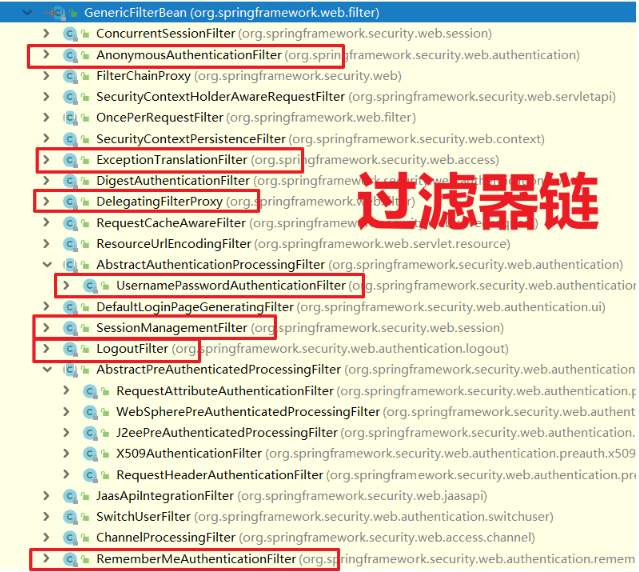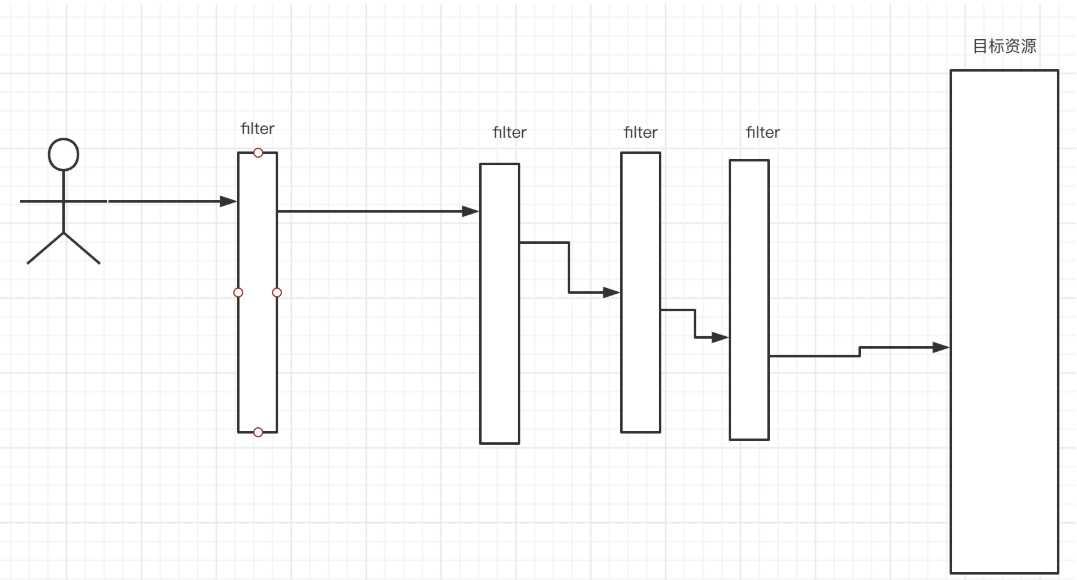SpringSecurity
1, Overview
- Official website: https://spring.io/projects/spring-security SpringSecurity official website
- Spring security is a security framework based on authentication and authorization developed by spring company
- Authentication: login process
- Authorization: grant corresponding operation permissions during login
- General permission management is RBAC
- RBAC: role based access control

2, Quick start
1. Implementation steps
- Create a SpringBoot project
- Import dependency
- controller
- Start project
- access controller
2. Concrete realization
2.1 import dependency
<dependency>
<groupId>org.springframework.boot</groupId>
<artifactId>spring-boot-starter-web</artifactId>
</dependency>
<dependency>
<groupId>org.springframework.boot</groupId>
<artifactId>spring-boot-starter-security</artifactId>
</dependency>
2.2 interface
@RestController
public class HelloController {
@RequestMapping("/hello")
public String hello(){
return "Hello,Success!";
}
}
2.3 testing
-
Access interface
If blocked, jump back to the login page
If the login is successful, jump to the previously accessed resources
User name: user
Password: randomly generated by console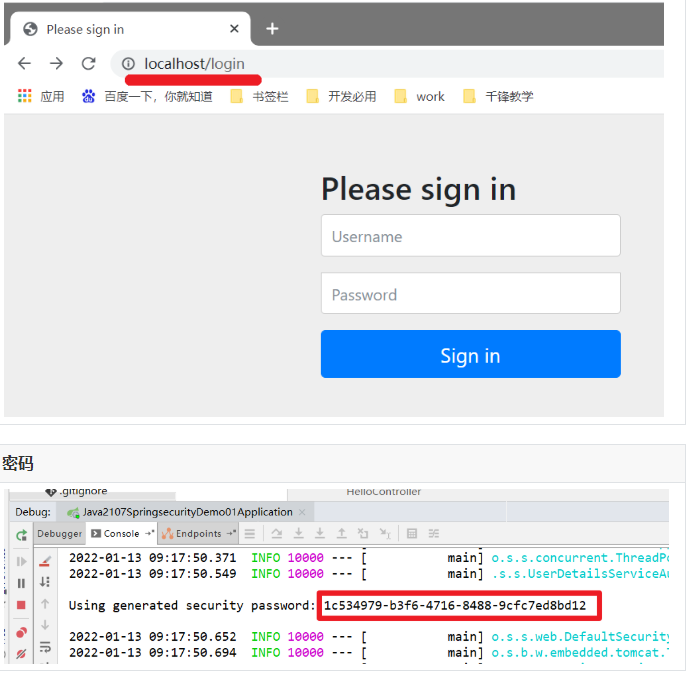
3, Configure user name and password
1. SpringBoot configuration file
spring:
#Specify user name and password
security:
user:
name: java2107
password: java2107
2. Configuration class
2.1 memory based [understand]
- Annotation profile
- The boot class adds an encrypted Bean
@Bean
public PasswordEncoder passwordEncoder(){
return new BCryptPasswordEncoder();
}
- Add configuration class
@Configuration
public class SecurityConfig extends WebSecurityConfigurerAdapter {
@Autowired
PasswordEncoder passwordEncoder;
@Override
protected void configure(AuthenticationManagerBuilder auth) throws Exception {
String newPwd = passwordEncoder.encode("java2107");
//Configure user name and password based on memory
auth.inMemoryAuthentication()
.withUser("java2107")
//This password must be encrypted. You need to specify an encryptor
.password(newPwd)
//Specify the role. The specific role can not be specified
.roles("");
}
}
- test
2.2 user defined authentication class
- The memory based configuration should be commented out
- Implement interface UserDetailsService
@Service
public class MyUserDetailsService implements UserDetailsService {
@Override
public UserDetails loadUserByUsername(String username) throws UsernameNotFoundException {
if(null != username && "java2107".equals(username)) {
//Comparing passwords, the security framework will automatically compare passwords
//Parameter 1: user name of database
//Parameter 2: password of database $2A $10 $mfcvabmb7imtus0vuv / sxusikseb / evam8xqekj0pewmo9m23umfs -- > java2107
//Parameter 3: role permission list
Collection<? extends GrantedAuthority> authorities =
AuthorityUtils.commaSeparatedStringToAuthorityList("");
return new User(username,
"$2a$10$mFcvAbMb7iMtuS0vuv/sXuSiKSeb/EVAM8xQekJ0PEWmo9M23UMfS",
authorities);
}
//Certification failed
return null;
}
}
- Configuration class based on authentication class
@Override
protected void configure(AuthenticationManagerBuilder auth) throws Exception {
//Based on authentication class
//Which authentication class to pass for authentication. When comparing passwords, ciphertext passwords shall be compared with plaintext passwords [encryptor needs to be specified]
auth.userDetailsService(myUserDetailsService).passwordEncoder(passwordEncoder);
}
4, Connect to database
1. Database table
CREATE TABLE `tb_user` ( `id` int(11) NOT NULL AUTO_INCREMENT, `username` varchar(30) DEFAULT NULL, `password` varchar(60) DEFAULT NULL, PRIMARY KEY (`id`) ) ENGINE=InnoDB AUTO_INCREMENT=3 DEFAULT CHARSET=utf8; insert into `tb_user`(`id`,`username`,`password`) values (1,'zhangsan','123456'); #The password needs to be encrypted. Encrypt it yourself
2. Import dependency
<dependency>
<groupId>com.baomidou</groupId>
<artifactId>mybatis-plus-boot-starter</artifactId>
<version>3.1.1</version>
</dependency>
<dependency>
<groupId>mysql</groupId>
<artifactId>mysql-connector-java</artifactId>
</dependency>
<dependency>
<groupId>com.alibaba</groupId>
<artifactId>druid-spring-boot-starter</artifactId>
<version>1.1.10</version>
</dependency>
<dependency>
<groupId>org.projectlombok</groupId>
<artifactId>lombok</artifactId>
</dependency>
<dependency>
<groupId>com.github.pagehelper</groupId>
<artifactId>pagehelper-spring-boot-starter</artifactId>
<version>1.3.0</version>
</dependency>
3. Entity class
@Data
@NoArgsConstructor
@AllArgsConstructor
@TableName("tb_user")
public class TbUser implements Serializable {
@TableId
private Integer id;
private String username;
private String password;
}
4. Mapper interface
public interface TbUserMapper extends BaseMapper<TbUser> {
}
5. Guide class annotation
@MapperScan(basePackages = {"com.qf.java2107.springsecurity.demo01.mapper"})
Boot class
6. Transformation certification
Query user data by user name
package com.qf.java2107.springsecurity.demo01.service;
import com.baomidou.mybatisplus.core.conditions.query.QueryWrapper;
import com.qf.java2107.springsecurity.demo01.mapper.TbUserMapper;
import com.qf.java2107.springsecurity.demo01.pojo.TbUser;
import org.springframework.beans.factory.annotation.Autowired;
import org.springframework.security.core.GrantedAuthority;
import org.springframework.security.core.authority.AuthorityUtils;
import org.springframework.security.core.userdetails.User;
import org.springframework.security.core.userdetails.UserDetails;
import org.springframework.security.core.userdetails.UserDetailsService;
import org.springframework.security.core.userdetails.UsernameNotFoundException;
import org.springframework.security.crypto.password.PasswordEncoder;
import org.springframework.stereotype.Service;
import java.util.Collection;
/**
* Custom authentication class
* @author ghy
* @version 1.0
* @date 2022-01-13
**/
@Service
public class MyUserDetailsService implements UserDetailsService {
@Autowired
TbUserMapper tbUserMapper;
@Override
public UserDetails loadUserByUsername(String username) throws UsernameNotFoundException {
QueryWrapper<TbUser> wrapper = new QueryWrapper<>();
wrapper.eq("username", username);
//Query user table by user name
TbUser tbUser = tbUserMapper.selectOne(wrapper);
if(null != tbUser) {
Collection<? extends GrantedAuthority> authorities =
AuthorityUtils.commaSeparatedStringToAuthorityList("");
return new User(tbUser.getUsername(), tbUser.getPassword(), authorities);
}
//Certification failed
return null;
}
}
7. Test
Enter the user name and password for the database
8. Get user name
- The Security framework will allocate an anonymous account for the resources filtered by the framework. The account has not been authenticated, but Security will allocate a temporary account anonymous user for unauthenticated users to access some resources
@GetMapping("/show/name")
public String name(){
//Authentication object: after the resource passes through the Security framework, it will not be empty. The Security framework assigns an anonymous account to unauthenticated users to access some resources
Object principal = SecurityContextHolder.getContext().getAuthentication().getPrincipal();
if(null == principal) {
return "anonymous";
}
//Certified
if(principal instanceof User) {
User user = (User) principal;
return user.getUsername();
}
return principal.toString();
}
5, Security configuration
1. User defined login form
- By default, Security automatically generates a login form for unauthenticated users
- If it is our own project, the login form may not match the static resources of our project
1.1 implementation
Custom login form:
- User name: username
- Password: password
- Login request URL: / login
- Front page
<!-- use security After that, the login request is handled by it without writing it yourself Controller -->
<form action="/user/login" method="post">
user name:<input type="text" name="username"/><br>
password:<input type="text" name="password"/><br>
<input type="submit" value="Sign in"/><br>
</form>
- Configuration class [close cross site forgery request]
/**
* Configuration of authentication resources
* @param http
* @throws Exception
*/
@Override
protected void configure(HttpSecurity http) throws Exception {
http.formLogin()
.loginPage("/login.html")
.loginProcessingUrl("/user/login")
//The name value of the user name and password in the login form
//.usernameParameter("username").passwordParameter("password")
//If you directly access the login page and do not specify a target resource, skip to / success
.defaultSuccessUrl("/success")
//Release
.permitAll()
//Open another configuration and use and to separate
.and()
//Specify rules to intercept resources
//All requests can be accessed as long as they are authenticated
.authorizeRequests().anyRequest().authenticated()
//Turn off cross site forgery request
.and().csrf().disable();
}
2. Configure interception rules
2.1 configure resources that have passed the Security framework but do not require authentication
- For example: Welcome page, registration page
- Add test interface
@RestController
public class HelloController {
//Add test interface
@RequestMapping({"/","/index"})
public String index(){
return "Hello,index!!";
}
}
- Security configuration class
//Configure the interception rules and the resources to be released [through security]
.and().authorizeRequests().antMatchers("/","/index","/user/show/name").permitAll()
@Override
protected void configure(HttpSecurity http) throws Exception {
http.formLogin()
.loginPage("/login.html")
.loginProcessingUrl("/user/login")
//The name value of the user name and password in the login form
//.usernameParameter("username").passwordParameter("password")
//If you directly access the login page and do not specify a target resource, skip to / success
.defaultSuccessUrl("/success")
//Release
.permitAll()
//Configure the interception rules and the resources to be released [through security]
.and().authorizeRequests().antMatchers("/","/index","/user/show/name").permitAll()
//Open another configuration and use and to separate
.and()
//Specify rules to intercept resources
//All requests can be accessed as long as they are authenticated
.authorizeRequests().anyRequest().authenticated()
//Turn off cross site forgery request
.and().csrf().disable();
}
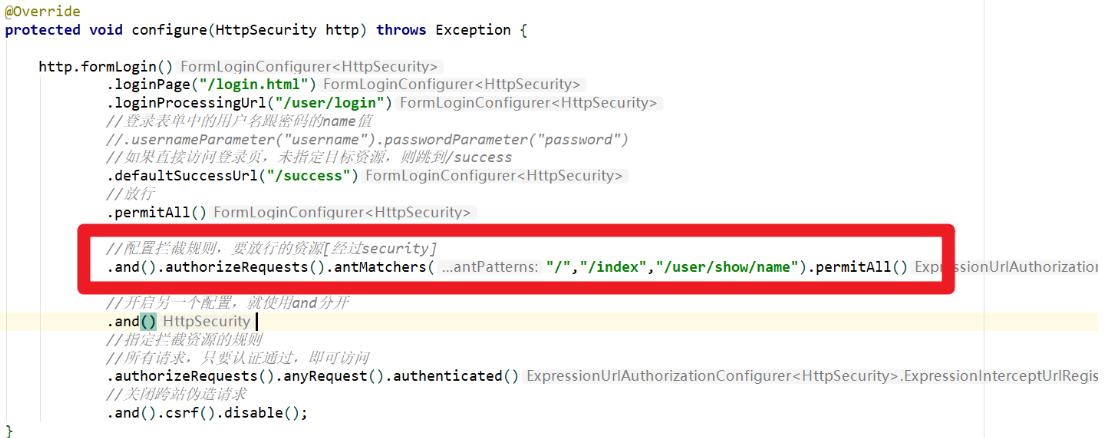
3. Role based permission interception
How does Security determine whether it is currently given a role or permission
- ROLE: in ROLE_ start
- Permission: either role or permission, and ordinary string is permission
- Add test interface
@RestController
@RequestMapping("/order")
public class OrderController {
@GetMapping("/list")
public String list(){
return "order list";
}
}
- Security configuration class
// hasRole: single role.
// hasAnyRole: just meet one of the roles
// hasAuthority(): single authority
// hasAnyAuthority(): as long as one of the permissions is satisfied
// hasRole and hasAnyRole do not add ROLE here_ prefix
//When intercepting resources, write exact matching first, and then fuzzy matching
//Access to the product/list resource requires product_list permissions
.and().authorizeRequests().antMatchers("/product/list").hasAnyAuthority("product_list")
//The user role is required to access resources in the product controller
.and().authorizeRequests().antMatchers("/product/**").hasRole("user")
//The order role is required to access the / order / * * resource
.and().authorizeRequests().antMatchers("/order/**").hasAnyRole("order")
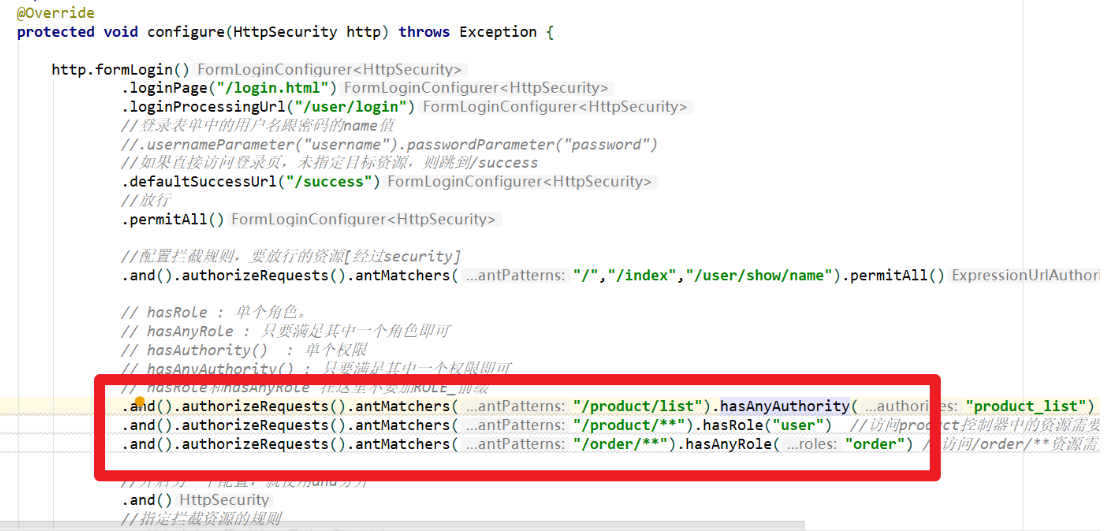
- Testing (giving roles or permissions during authentication for testing)

- If there is no corresponding role or permission, 403 error [insufficient permission] will appear
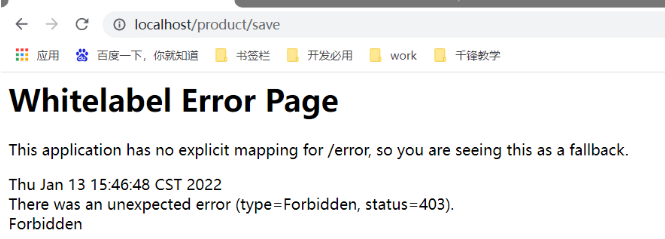
- Insufficient custom permissions page
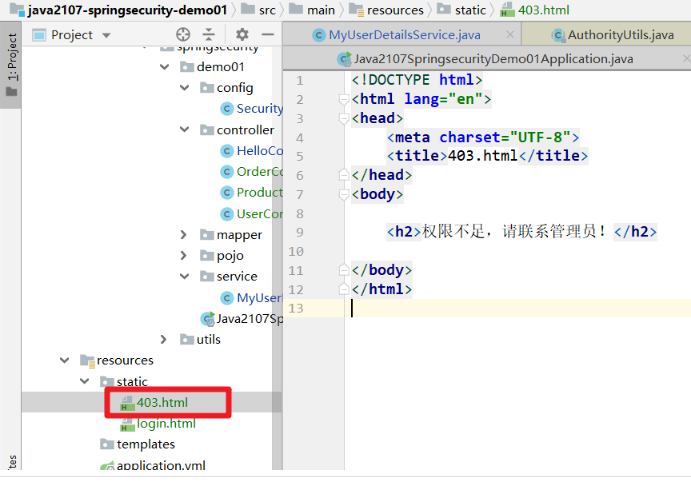
- Security configuration class add configuration

4. Method level based interception
4.1 note global interception configuration

4.2 implementation annotation (common)
4.2.1 @Secured
Role based access control: whether there is permission to access the target method
-
Processor annotation

-
Enable annotation to take effect
@EnableGlobalMethodSecurity(securedEnabled = true)
Boot class

4.2.2 @PreAuthorize
Specify roles or permissions based on API to control whether you have permission to access the target method [control before method]
-
Processor annotation
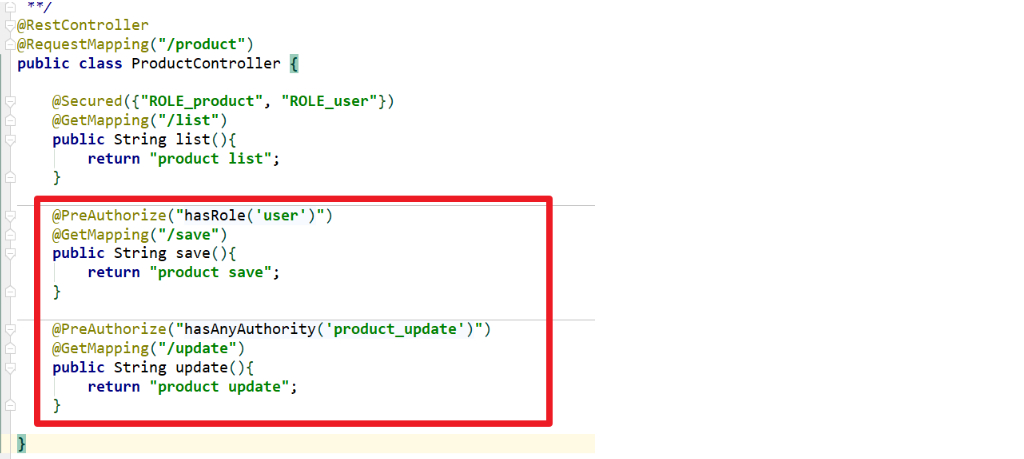
-
Enable annotation to take effect
Boot class

4.2.3 @PostAuthorize
You can access the target processor, but you must have the corresponding roles or permissions to get the returned results

5. Expression writing
https://docs.spring.io/spring-security/site/docs/5.3.4.RELEASE/reference/html5/#el-access
6. Logout
Default logout URL: / logout
- Security configuration class
.and().logout().logoutUrl("/user/logout").logoutSuccessUrl("/login.html")
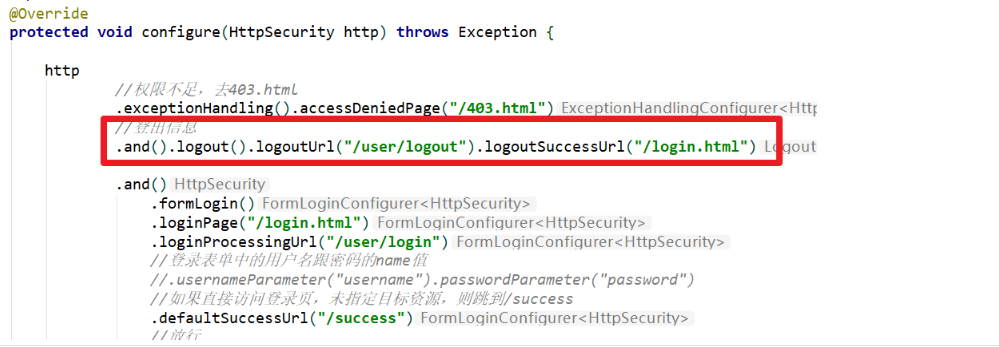
- Make a login success page and let it exit
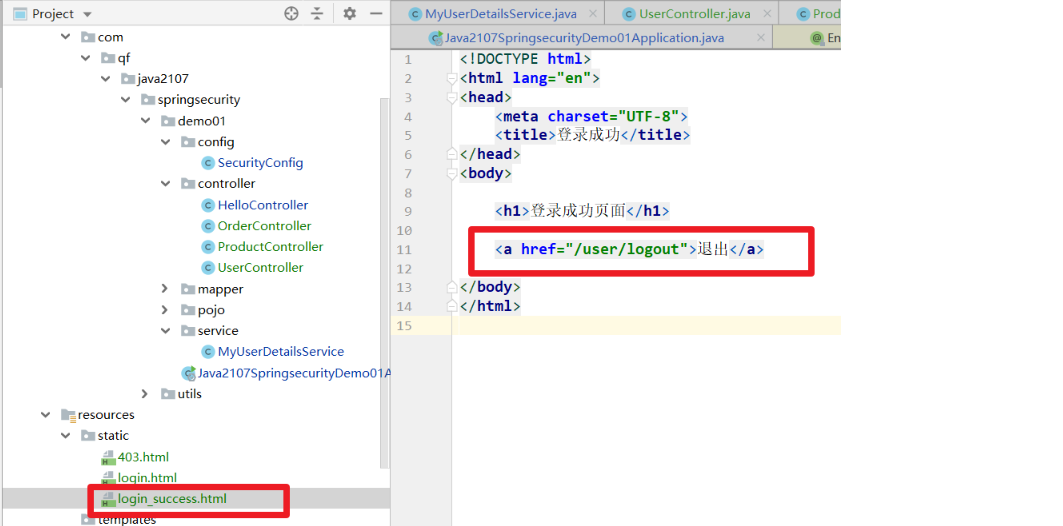
6, Working principle
When the client requests resources from the server, it actually goes through a filter chain encapsulated by spring security to finally reach the directory resources. After obtaining the directory resources, execute the filter chain, and then respond to the client
- Filter chain: a filter chain is composed of N filters, and spring security completes authentication and authorization through these filters.
- You will find the corresponding filter to work on what kind of operation to perform
